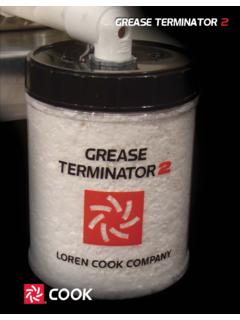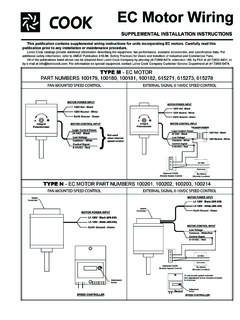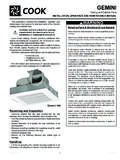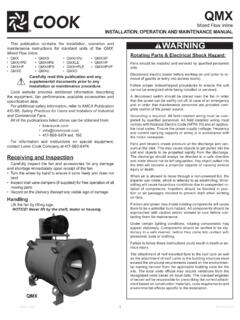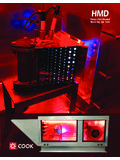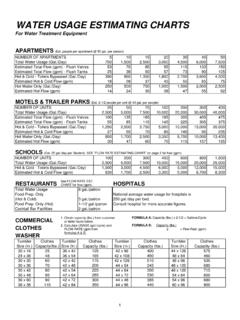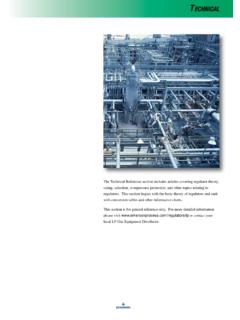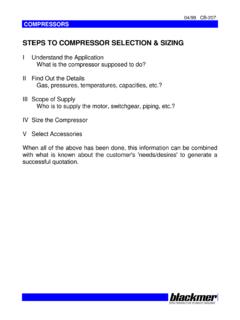Transcription of ENGINEERING COOKBOOK - LOREN COOK COMPANY :A …
1 A Handbook for theMechanical COOKBOOKLOREN COOK COMPANY1 ENGINEERING CookbookA Handbook For The Mechanical Designer Third EditionThis handy pocket reference is a token of LOREN COOK COMPANY s appreciation to the many fine mechanical designers in our industry. It provides access to frequently needed information: Fan Basics System Design Duct Design Motors & Drives Heating & Refrigeration Formulas & Conversion FactorsDownloadsAvailable in PDF format at and as a free app through Google Play or Apple Cook COMPANY Copyright 2015 Springfield, Missouri, USA 2 Table of ContentsFan Basics, 1 Fan Types ..1 Axial Fans ..1 Mixed Flow Fans ..4 Centrifugal Fans ..5 Basic Components ..5 Airfoil ..7 Backward Inclined ..7 Radial ..8 Forward Curved ..8 Drive Arrangements ..9 Motor Positions and Rotation .. 11 Inlet Boxes ..12 Rotation and Discharge Designations .. 13 Spark Resistant Construction ..15 Basic Terms ..17 Fan Selection Criteria.
2 18 Fan Testing ..18 Fan Classes of Operation ..19 Operating Limits Chart-Centrifugal AF and BI Fans-SWSI ..20 Performance Correction for Altitude and Temperature ..21 Fan Laws ..22 Fan Balancing ..23 Vibration Severity ..25 Vibration ..27 Fan Troubleshooting Guide ..28 System Design, 29 General Ventilation Guidelines ..29 Process Ventilation Guidelines ..29 Kitchen Ventilation Guidelines ..29 Ventilation Rates for Acceptable Indoor Air Quality ..31 Heat Removal Method ..31 Heat Gain from Occupants of Conditioned Spaces ..32 Rate of Heat Gain from Appliances and Equipment ..33 Commercial Hooded Cooking Appliances ..33 Commercial Unhooded Electric Cooking Appliances ..33 Miscellaneous Appliances ..35 Office Equipment ..35 Heat Gain from Electric Motors ..36 Air Filtration ..37 Relative Size Chart of Common Air Containments ..38 Filter Application Guidelines ..39 Minimum Efficiency Reporting Value (MERV) Parameters 40 Sound ..41 Rules of Thumb ..41 Noise Criteria (NC).
3 42 Adding Sound Pressure Levels ..433 System Design (cont.) Sound Power and Sound Power Levels ..43 Sound Pressure and Sound Pressure Levels ..44 Room Sones - dBA Correlation ..44 Design Criteria for Room Loudness (Sones) ..45 Seismic and Wind Forces ..47 Seismic Forces ..47 Wind Forces ..48 Duct Design, 49 Maximum Duct Velocities ..49 Duct Loss Estimating ..49 Sample System Layout ..51 Duct Loss Estimation Example ..52 Fitting Loss Charts ..54 Round Elbows ..54 Tee (Double Elbow) ..55 Rectangular Radius Elbows ..56 Wye (Double Elbow Equivalent) ..56 Converging Tee Rectangular Trunk (Branch Path) ..57 Converting Tee Rectangular Trunk (Trunk Path} ..58 Diverging Tee Rectangular Trunk (Branch Path) ..59 Diverging Tee Rectangular Trunk (Trunk Path) ..60 Tee, Round, 90 degree (Branch Path) ..61 Tee, Round, 90 degree (Trunk Path) ..62 Diverging Tee Round Trunk (Branch Path) ..63 Diverging Tee Round Trunk (Trunk Path) ..64 Wye Rectangular or Round (Pair of Pants).)
4 65 Transition Expanding Flow ..66 Transition Contracting Flow ..67 Fitting Loss Conversion Factors ..68 Typical Design Velocities for HVAC Components ..69 Velocity and Pressure Relationships ..70 Rectangular Equivalent of Round Ducts ..71 Duct Resistance .. Sheet Metal Gauges ..73 Recommended Duct Metal Gauges ..73 Duct Pressure and Leakage Classes ..74 Typical Inlet Conditions ..75 Typical Outlet Conditions ..76 Motors & Drives, 77 Terms and Formulas ..77 Motor Efficiency and EISA ..78 Premium Efficient Electric Motors Full Load Efficiencies 79 Open Motors ..79 Enclosed Motors ..80 Alternating Current Motor Characteristics ..81 Single Phase AC Motors ..81 4 Motors & Drives (cont.) Three Phase AC Motors ..81 Typical Speeds - Three Phase AC Motors..82 NEMA Torque Designs for Three Phase Motors ..82 Full Load Amp Draw ..83 Single Phase Motors ..83 Three Phase Motors ..84 Motor Service Factors ..85 Motor Insulation Classes.
5 85HP Rerate for Altitude and Temperature ..86 Locked Rotor KVA/HP ..86 General Effect of Voltage and Frequency Variations on Induction Motor Characteristics .. 87AC Motor Troubleshooting Guide ..88 Electronically Commutated Motors ..91 AC Induction Motor Losses ..91 EC Motor Losses ..91 Reduced Speeds ..92 Other Advantages of EC Motors ..92 Allowable Ampacities ..93 Copper Conductor ..93 Aluminum or Copper-Clad Conductor ..94 Belts ..95 V-belt Length Formula ..95 Belt Drive Guidelines ..95 Estimated Belt Drive Loss ..96 Bearing Life ..97 Heating & Refrigeration, 99 Moisture & Air Relationships ..99 Properties of Saturated Steam ..100 Fuel Comparisons ..101 Fuel Gas Characteristics ..101 Annual Fuel Usage ..102 Water Flow & Piping ..103 Quiet Water Flows ..103 Friction Loss for Water Flow ..104 Equivalent Length of Pipe for Valves & Fittings ..105 Standard Pipe Dimensions ..106 Schedule 40 (Steel) ..106 Copper Tube (Type L) ..106 Pump Impeller Types.
6 107 Pump Bodies ..107 Pump Mounting Methods ..107 Pump Terms, Abbreviations & Conversion Factors ..108 Affinity Laws for Pumps ..109 Common Pump Formulas ..109 Pumping System Troubleshooting Guide ..1115 Heating & Refrigeration (cont.)Noise ..111 Inadequate or No Circulation ..112 Cooling Tower Ratings ..113 Horsepower per Ton ..113 Fouling Factors ..115 Typical Heat Transfer Coefficients ..115 Evaporative Condenser Ratings ..116 Compressor Capacity vs. Refrigerant ..116 Refrigerant Line Capacities ..117 R-134a ..117 R-410a ..117 R-502 ..118 R-717 ..118 Formulas and Conversion Factors, 119 Miscellaneous Formulas ..119 Power: AC Circuits ..119 Power: DC Circuits ..119 Speed: AC Machinery ..120 Ohms Law ..120 Motor Application ..120 Motor Ramp Up Time (Seconds) ..120 Change in Resistance Due to Change in Temperature ..121 Vibration ..121 Volume of Liquid in Tank ..121 Pumps ..121 Fans & Blowers ..122 Temperature ..122 Conversion Factors.
7 123 Area and Circumference of Circles ..129 Circle Formulas ..131 Fractions of an Inch ..132 Psychrometric Chart ..133 Index, 134 1 Fan TypesFans are described in three types and several Propeller Tube Axial Vane AxialMixed Flow Low Pressure High Pressure Extended PressureCentrifugal Airfoil Backward Inclined Radial Forward CurvedAxial Fans An axial fan discharges air parallel to the axis of the impeller Fans Cost is generally low Blades attached to a relatively small hub Energy transfer is primarily in the form of velocity pressure Primarily for low pressure, high volume, non-ducted applications Cutaway ViewFan Basics2 Tube Axial Fans More useful static pressure range than propeller fans Axial impeller in a tubular housing Blade cross-section either single thickness or airfoil Primarily for low to medium pressure applications such as ducted HVAC applications where downstream air distribution is not critical Cutaway ViewFan Basics 3 Vane Axial Fans Axial impeller in a tubular housing with straightening vanes which improve pressure capabilities & efficiency Cost is generally high Generate medium-to-high pressure at good efficiencies Fixed or adjustable pitch blades Hub diameter is greater than 50% of impeller diameter Used for straight-through flow and compact installations Downstream air distribution is good Noise levels may be high Used for general HVAC in a wide range of pressure applications Industrial applications include.
8 Drying ovens, paint spray booths, and fume exhaust systems Cutaway ViewFan Basics4 Mixed Flow FansHigh PressureLow PressureA mixed flow fan is a hybrid of an axial and a centrifugal fan, with a smaller backplate and angled blades. It discharges air parallel to the axis of the impeller rotation. As a general rule, it is more efficient, smaller and quieter when used in ducted, inline, supply and exhaust. Best selection for most inline airflow applications Higher pressure ability than axial Lower sound levels than equally sized centrifugal inline units Lower rpm than equal sized inline units, for the same flow and pressure Does not require inlet bell or outlet coneCutaway ViewExtendedPressureFan Basics 5 Centrifugal FansA centrifugal fan draws in air parallel to the axis of rotation and discharges air perpendicular to the axis of rotation. The air then follows the shape of the fan housing to exit. In general, centrifugal fans are preferred for ducted or higher-pressure PanelHousingScrollCutoffImpellerOutletBa sic ComponentsInletLifting LugBearingSupportDWDI Double Width Double InletSWSI Single Width Single InletFan Basics6 Centrifugal fans are the workhorse of the fan industry, operating in a wide variety of configurations, duties and environments.
9 From light commercial, non-ducted applications to high pressure industrial and process ventilation, centrifugal fans can often be configured to meet the application demands. Examples are shown on these two pages. Centrifugal Power Roof VentilatorFan BasicsCentrifugal Kitchen ExhaustSquare Inline Centrifugal 7 Airfoil (AF) Fans Highest efficiency of centrifugal impeller designs 10-12 airfoil blades inclined away from the direction of rotation Relatively deep blades provide for efficient expansion Primarily used in general HVAC systems Industrial use in clean air applicationsBackward Inclined (BI) Fans Efficiency slightly less than airfoil 10-12 single thickness blades inclined away from the direction of rotation Relatively deep blades provide for efficient expansion within blade passages Primarily used in general HVAC systems Industrial applications where airfoil blade is not acceptable due to a corrosive and/or erosive airstreamFan Basics8 Radial Fans Less efficient than airfoil or backward inclined fans High mechanical strength High speed at given duty relative to other designs 6-10 blades arrayed in a radial configuration Primarily used for material handling applications in industrial environments Often specially coated to resist corrosion or surface erosion Used in high pressure applications not commonly found in HVAC Curved (FC)
10 Fans Less efficient than airfoil or backward inclined fans Low cost to manufacture Lightweight construction 24-64 shallow blades with blade heel and tip curved in direction of rotation Smallest wheel diameter for given duty of all centrifugal fans types Most efficient at low speeds Primary uses are low pressure HVAC applications such as residential furnaces and packaged air conditioning equipmentFan Basics 9 Drive Arrangements for Centrifugal FansSWSI: Single Width, Single InletDWDI: Double Width, Double InletArr. 1 SWSI: Belt drive or direct drive. Impeller over-hung. Two bearings on 2 SWSI: Belt drive or direct drive. Bearings on bracket supported by fan 3 SWSI: Belt drive or direct drive. One bearing on each side supported by fan 3 DWDI: Same configuration as Arrangement 3 SWSIArr. 4 SWSI: Direct drive. Impeller overhung on motor shaft. No bearings on fan. Motor mounted on 5 SWSI: Direct drive. Impeller overhung on motor. No bearings on fan. Motor mounted to fan housing.
